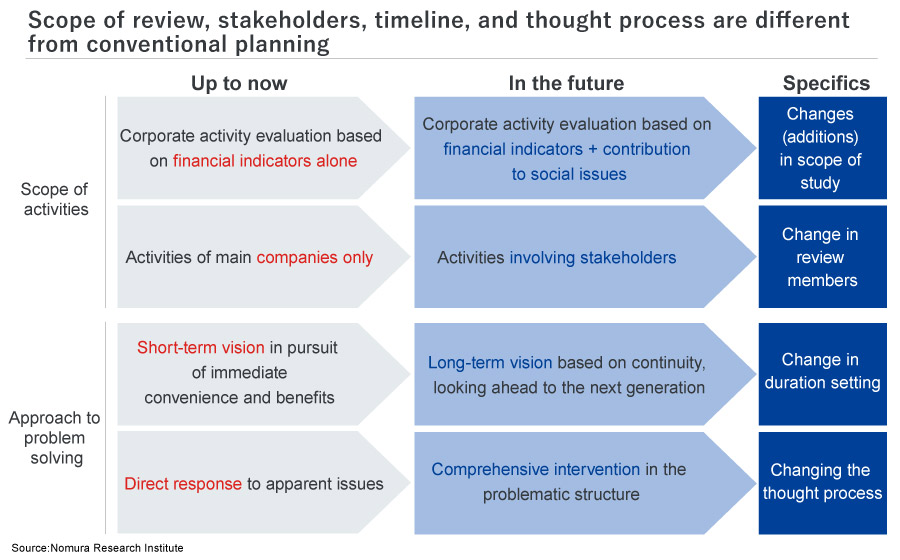
How to Achieve Social Value Along with Economic Value: Rethinking Management Plans from a Long-Term Perspective
The response to global social issues and ESG (Environment, Society, and Governance) is becoming increasingly important for corporate management. Accordingly, many companies feel that the growth of their businesses and the realization of social value are not well linked in their existing medium-term management plans. We asked Eiko Ibuki and Ryuhei Hanyu of Nomura Research Institute (NRI), who are experts in this field, about incorporating the perspective of sustainability into management.
Conventional Medium-Term Management Plans Cannot Cope with Environmental Changes
―― What are the drawbacks of conventional medium-term management plans when aiming for sustainable management?
Currently, the medium-term management plans of many companies consist mainly of financial indicators. Even if social value is mentioned in the management philosophy, it is often not reflected in the actual management plans. Hence, day-to-day operations tend to diverge, with a focus on financial management cycles. Moreover, conventional medium-term management plans often set a span of about three years, and depending on the circumstances of the company, it may not be possible to respond to environmental changes within that timeframe. Let us take the example of autonomous cars. We have been trying to put autonomous cars on public roads for almost two years now, but some more time is still needed before they can become a reality. In spite of rapid technological evolution, it is difficult to achieve financial results in two to three years. If we do not take a long-term view, it is difficult to commercialize new technologies and successfully incorporate them into existing businesses.
Meanwhile, long-term management plans have limitations in setting financial targets. This is because numerical values cannot be predicted correctly in a rapidly changing and uncertain environment. Accordingly, an increasing number of companies are seeking to review their long-term visions and medium-term management plans from the perspective of social value.
Strategies to Link Financial and Social Value
―― What is the actual process of the review?
The process involves three steps: clarification of the starting point, anticipation of future challenges, and building a path to the future. First, we reaffirm and share the basic management philosophy in order to identify “Who are we?” and reflect on the history of the company. We then discuss what needs to be changed and what needs to be kept as it is. Additionally, we identify the principles that the management identifies as important and clarify the challenges faced by the company.
Next, we discuss the future. We may also discuss the possibility of business development over the next 10 to 15 years. In doing so, it is important to have a broad perspective and not to think only about the industry to which we belong. For example, if supermarkets focus on meals, they will compete not only with supermarkets in the same industry but also with downtown delicatessen and boxed lunch shops. A change in business domain leads to a change in competitors and partners as well. Therefore, the scope, the expertise, and the rules that must be considered also change. We thoroughly discuss how and to what extent we need to make changes, taking into account the timeline, our own strengths, and the strength of the company.
We then develop a scenario and framework for the long-term vision. In order to create a narrative conducive to growth and sustainability in terms of both economic value and social value, it is necessary to explore and discuss the truly important social issues for the company as well as to examine the relationship and find the balance between financial and non-financial aspects. In particular, social issues may sometimes not be resolved by the company alone, but require collaboration with competitors, NPOs/NGOs, or the government. We can come up with a variety of growth stories by thinking not only about what we should do but also about the stakeholders around us. A clear narrative facilitates communication and collaboration with stakeholders and also garners customer sympathy and support.

Involving the Next-Generation Management and Transforming the Thought Process
―― Is there anything we need to keep in mind in the above series of steps?
First of all, it is important to involve not only the current executives but also the next generation of managers in these discussions. By understanding the thought behind the long-term vision, it will be possible to formulate a storyline for the medium-term plan based on the content discussed. As the latter is converted into an action plan on-site, its feasibility and the ability to implement it will vary.
Meanwhile, the second step, which involves considering the future, can be confusing. If we think of it as forecasting the future, we tend to end up collecting statistics and discussing the likelihood of events. The future, however, is something that we ourselves shape. Nevertheless, if we really need something to rely on, the United Nations' Sustainable Development Goals (international goals for the year 2030) can be a good model. In addition to being a common language that aligns the premise of the discussion, SDGs can also be tools to change vision and perspective and help transform mindset. Not only do they give an idea of the kind of business that can be developed with existing technology and management resources, but they also provide an opportunity for backcasting and thinking about how the company's technology and products can contribute to their target social issues in the future.
NRI will redefine the company's direction from a long-term perspective, and, using an unorthodox thought process, create a storyline and strategy to combine the financial and non-financial aspects. We will also provide support with activities that lead to sustainable corporate growth.

Mr. Ryuhei Hanyu (L) and Ms. Eiko Ibuki (R) of NRI
NRI boasts its Principals holding high level of expertise in specific markets or solutions. NRI Principals, also as leading consultants, have played roles to lead innovations for society and clients to success. NRI Principals create new businesses, ensure unwavering commitment to projects and have responsibilities to solve the client's issues.
Profile
-
Eiko Ibuki
-
Ryuhei Hanyu
* Organization names and job titles may differ from the current version.